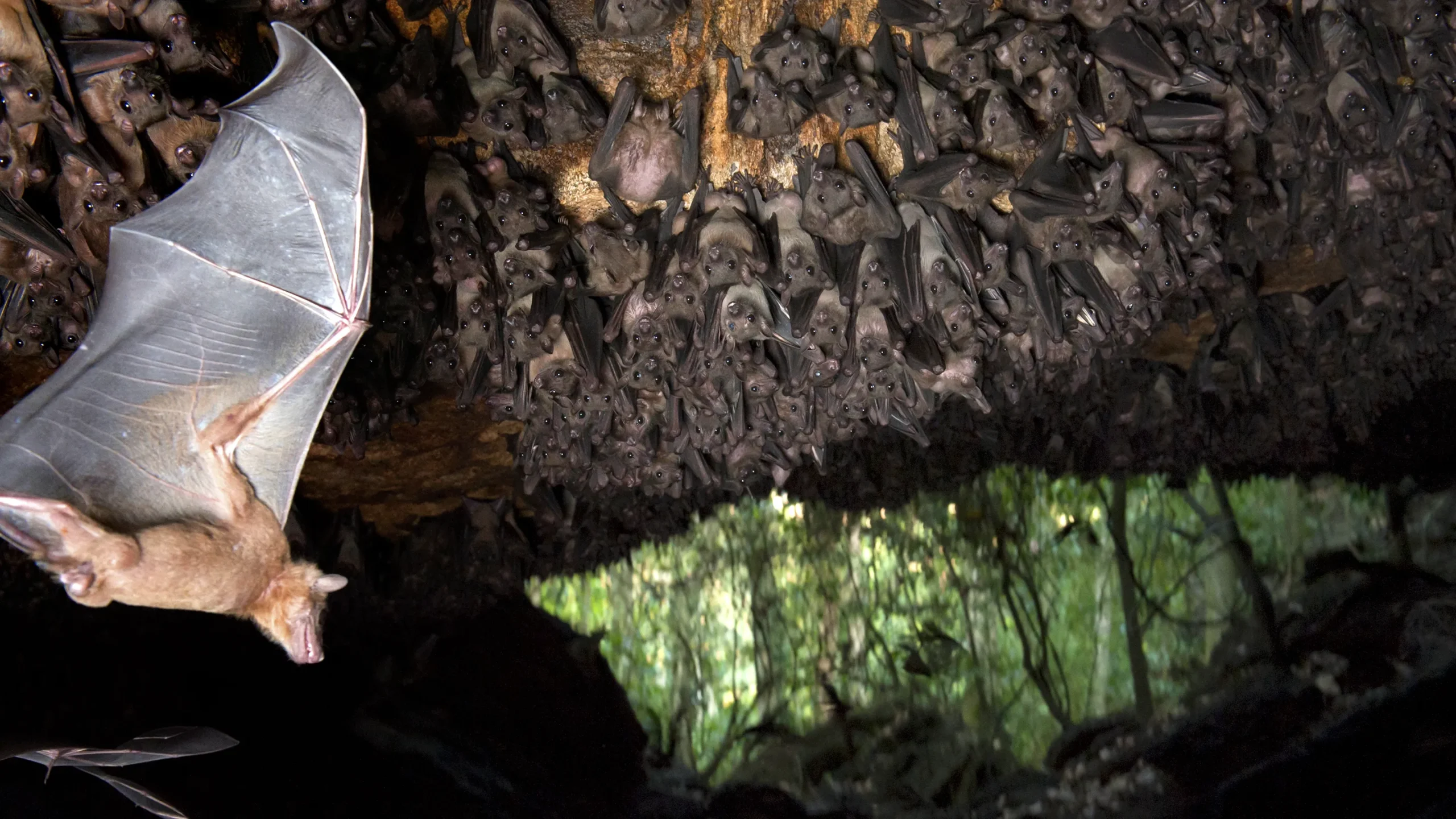Bats Use the Same Brain Cells to Map Physical and Social Worlds

In the wild, Egyptian fruit bats live inside highly social cave environments, sometimes with thousands of other bats.
Joel Sartore
Introduction
A fruit bat hanging in the corner of a cave stirs; it is ready to move. It scans the space to look for a free perch and then takes flight, adjusting its membranous wings to angle an approach to a spot next to one of its fuzzy fellows. As it does so, neurological data lifted from its brain is broadcast to sensors installed in the cave’s walls.
This is no balmy cave along the Mediterranean Sea. The group of Egyptian fruit bats is in Berkeley, California, navigating an artificial cave in a laboratory that researchers have set up to study the inner workings of the animals’ minds.
The researchers had an idea: that as a bat navigates its physical environment, it’s also navigating a network of social relationships. They wanted to know whether the bats use the same or different parts of their brain to map these intersecting realities.
In a new study published in Nature in August, the scientists revealed that these maps overlap. The brain cells informing a bat of its own location also encode details about other bats nearby — not only their location, but also their identities. The findings raise the intriguing possibility that evolution can program those neurons for multiple purposes to serve the needs of different species.
The neurons in question are located in the hippocampus, a structure deep within the mammalian brain that is involved in the creation of long-term memories. A special population of hippocampal neurons, known as place cells, are thought to create an internal navigation system. First identified in the rat hippocampus in 1971 by the neuroscientist John O’Keefe, place cells fire when an animal is in a particular location; different place cells encode different places. This system helps animals determine where they are, where they need to go and how to get from here to there. In 2014, O’Keefe was awarded the Nobel Prize for his discovery of place cells, and over the last several decades they have been identified in multiple primate species, including humans.
However, moving from place to place isn’t the only way an animal can experience a change in its surroundings. In your home, the walls and furniture mostly stay the same from day to day, said Michael Yartsev, who studies the neural basis of natural behavior at the University of California, Berkeley and co-led the new work. But the social context of your living space could change quite regularly.
“If people come in, they move around, they interact,” Yartsev said. Where those people are located and the nature of your relationship with each individual influences how you’ll move through the space. “The spatial environment is very dynamic, but not because the walls are moving,” he said.
Yartsev thought that because the social environment is an ever-changing feature of the physical environment, information about it might be encoded in place cells. But no direct test had ever been performed in a highly social setting, such as in a fruit bat colony.
“This particular aspect [of the environment], which is so inherent to all of our lives, had never been studied before,” Yartsev said.
To gain insight into how the brain might navigate the social environment, Yartsev and his postdoctoral fellow Angelo Forli looked to Egyptian fruit bats, which they had previously used in studies of the brain’s navigation wiring.

The neuroscientists Michael Yartzev (leftO and Angelo Forli monitored the firing of bats’ neurons to find out if social data was encoded alongside location data in the brain.
Yuheng Feng
In Yartsev’s lab they built an artificial cave: a living room-size flight room designed to measure the bats’ brain activity while tracking their behavior. Five to seven bats at a time were free to fly about the room, which was lined with sound-dampening foam and equipped with perches and fruit to eat. To follow the bats’ precise 3D movements, the researchers outfitted collars with accelerometers and mobile tags — modified from systems used to track packages within warehouses — which communicated with sensors installed in the room’s walls. The team also implanted tiny electrodes into the bats’ brains to wirelessly record hippocampal neurons firing as the animals flew around their enclosure and interacted with each other.
The researchers put all this elaborate effort into their experimental setup so that they could investigate the bats’ spontaneous social interactions, which would presumably be like those experienced in the wild. That meant largely leaving the bats to their own devices without human meddling.
“The idea was just to take humans out of the room,” Yartsev said, and let bats do what bats normally do.
As expected, the place cells for a given bat changed their activity based on the bat’s location in the cave. Certain place cells fired more frequently when the bat was in a particular spot, while others increased their firing when the bat was someplace else.
The presence or absence of other bats also influenced the neurons’ firing. As a bat went in for a landing, the place cells behaved differently depending on whether there was a roostmate at the landing site. What’s more, the neurons appeared to encode the identity of specific bats, distinguishing friends from acquaintances. If a bat landed next to a close social contact, the neurons behaved differently than if it landed near a bat it didn’t spend much time with.
In short, the bats’ navigation system appeared to do double duty as a social map. The mammals weren’t just moving around their home — they were also using the exact same brain cells to track who was on the premises.
“[The researchers] knock it out of the park with respect to studying the neuroscience of a natural behavior,” said the behavioral neuroscientist Andy Alexander of the University of California, Santa Barbara, who was not involved in the study.
The discovery immediately spurred questions about whether this reuse of hippocampal place cells applies beyond Egyptian fruit bats in the evolution of the social brain. The hippocampus is an ancient brain structure: It is highly conserved among mammals with diverse lifestyles and degrees of sociality, from largely solitary platypuses to highly communal people. It’s possible that the hippocampus’s navigation system logs the social environment similarly across species. However, it’s equally possible that the place circuitry evolved this dual purpose only in the Egyptian fruit bat. Only additional research can fill in the gaps.
The findings go beyond the social map. They also fit with the concept of mixed selectivity, Alexander said: the idea that it’s more computationally efficient for single neurons to encode multiple features of the environment.
In that sense, Forli said, the hippocampus may be like a powerful graphics card in a computer, which can have many uses, from rendering graphics for video games to performing machine learning computations. The hippocampus may be great at particular kinds of computations and may have the ability to be modified or programmed by evolution.
“We’ve classically thought of the hippocampus as having these [place] cells that code particular locations in space,” Alexander said. “But I think more and more we’re discovering that it’s actually highly adaptive and flexible, and that the hippocampus will code for all sorts of things depending on what you present to it.”



